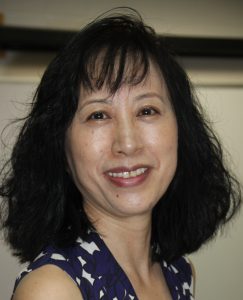 Dr. Aiwei Yao Borengasser is a biology and microbiology instructor in the biology department at the University of Arkansas – Pulaski Technical College. In addition to teaching, Aiwei has done extensive research on the ways obesity influences diabetes and the development of breast cancer, experience she often weaves into her lessons on biological molecules. Aiwei supports middle and high school science programs as a state-level science fair judge and by writing disease detection questions to challenge contestants at the Arkansas Science Olympiad.
Dr. Aiwei Yao Borengasser is a biology and microbiology instructor in the biology department at the University of Arkansas – Pulaski Technical College. In addition to teaching, Aiwei has done extensive research on the ways obesity influences diabetes and the development of breast cancer, experience she often weaves into her lessons on biological molecules. Aiwei supports middle and high school science programs as a state-level science fair judge and by writing disease detection questions to challenge contestants at the Arkansas Science Olympiad.
After completing ACUE’s foundations course at UA–Pulaski Tech, Aiwei plans to spend the summer reconstructing her teaching plan for the 2018-19 academic year using the practices she learned in the course, such as those she describes in this week’s Faculty Spotlight.
Discovering relevance
My typical students are not STEM majors; they’re taking one of my courses to fulfill a distributive requirement. They’re also scared that because they aren’t “into science” they won’t do well. When I start talking about scientific methods, I can see they are uneasy and that they don’t believe scientific methods have any relevance to their lives. This is when the “engagement trigger” technique I learned in the course was most useful. For instance, when I introduced the topic of hypotheses, I gave students a non-scientific-sounding scenario to start the lesson. “Consider this,” I said to them. “One day you discover you can’t get onto the Internet. What do you do? You come up with a hypothesis, such as, ‘Maybe when I vacuumed last night, I knocked out a cord.’ To test your hypothesis, you crawl under your desk to check, but you discover all the cords are in place. Your hypothesis is wrong, so you develop another hypothesis. You might think, ‘Hmm, I wonder if I forgot to pay the cable bill.’” When I had their attention, I asked for volunteers to tell me about a problem they solved recently, the steps they took, and so on, and I wrote their observations on the board. By the end of class, the students were fully invested. I asked them to write about what they learned on the subject of scientific methods. They had a lot to say, and they appeared to overcome those initial fears.
Mapping DNA mutations
ACUE’s concept mapping technique is a great tool for teaching DNA mutations. At the start of class, I asked my students to draw a circle and put the word “mutation” in the center. Then I asked them to draw several rays that extended from the circle and to write on each ray a term that represents a type of mutation. I discovered they could only come up with one or two examples and that all of their examples were diseases. I adjusted my lecture to address some of their misconceptions, describing, for instance, several positive outcomes from mutation, such as those occuring through evolution. After I lectured, I guided students in constructing another mutation concept map—this time, on the board. By now, each student could name several impacts of mutations, both good and bad, and there was a lot more energy in the room, with each student calling out 8 to 10 mutation outcomes. Using the diagram, I showed them how these mutations often relate to one another. Some students are logical and like to study from a list. But many of my students are visual learners who remember more when the information is in diagram form.
Restructuring to improve outcomes
I love to teach, but the ACUE course has made me reexamine my curricula. Employing the three-step process in the modules on aligning assessments, assignments, and activities with learning outcomes, I plan to redesign my biology and macrobiology courses for the fall semester and align my teaching methods to the learning outcomes I’m seeking for my students. In Step 1, I’ll ask myself whether I want them to recall information or analyze it. In Step 2, based on the outcome I’m looking for, I’ll determine whether to give students a quiz or a case study. Finally, in Step 3, I’ll identify the activities and assignments that will best align with the learning outcome. Does a group project make sense or is a research paper in order? Ultimately, I want my students to be able to apply their knowledge, not just take a test.
